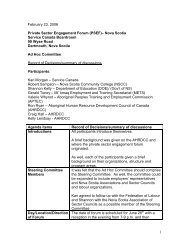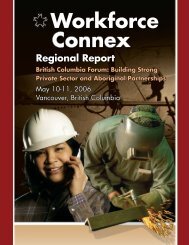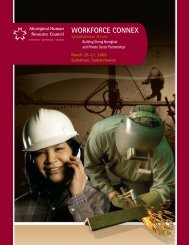Workforce connex - Aboriginal Human Resource Council
Workforce connex - Aboriginal Human Resource Council
Workforce connex - Aboriginal Human Resource Council
- No tags were found...
You also want an ePaper? Increase the reach of your titles
YUMPU automatically turns print PDFs into web optimized ePapers that Google loves.
Opening AddressMr. Lendsay introduced Claudette Bradshaw, past Minister of <strong>Human</strong> <strong>Resource</strong>sand Social Development Canada (HRSDC), and current lead on the NewBrunswick Community Non-Profit Task Force. Ms. Bradshaw was the ministerresponsible for HRSDC when the department’s roundtables were held thatresulted in the launch of the national <strong>Workforce</strong> Connex forum series.On a cross-country tour in 2005, Claudette Bradshaw brought employersand <strong>Aboriginal</strong> people together to find out why more <strong>Aboriginal</strong> people werenot participating in the labour force. She stated that her work was only thebeginning. She encouraged AHRC to take on this responsibility and coordinateactivities that would lead to the greater sharing of information that would resultin more partnerships. Mrs. Bradshaw felt that AHRC had a good team with theability to organize these forums. She was thrilled to see the forum’s come tolife, and was honoured to be asked a few words at the New Brunswick forum.During her tour across Canada Claudette noted that she discovered howvery little companies knew about whom <strong>Aboriginal</strong> people are, their skilllevels and how to get in contact the <strong>Aboriginal</strong> people. She also found thatthe <strong>Aboriginal</strong> community did not know how to connect with private sectoremployers or know about their job requirements and openings. She felt thatthese forums were an excellent way to have open dialogue to build partnershipsthat would eventually lead to <strong>Aboriginal</strong> employment. She explained thatfederal government can’t do the work that needs to be done because it doesnot go into the communities. Rather, communities tend to work with othergovernments’ and this is why forums are a good way to break down the barriers.She challenged participants to get active, get more engaged, to formpartnerships, and to help people to build their literacy and other skills.PART 2: Walk in my Shoes -A Personal ConnectionIn an effort to better understand each other’s challenges, the conversationreversed roles whereby the employers were asked to think/act like they werein the <strong>Aboriginal</strong>/AHRDA community while the <strong>Aboriginal</strong> community/AHRDAswere to think/act like they were employers, and determine, from this newperspective, the challenges? A summary of the conversation is as follows:AHRDAs as employers:QUESTION POSED: If you were an employer,what challenges would you face to make positiveconnections to the <strong>Aboriginal</strong> community?•••••How do I contact potential employees?Why can’t we find people?Where do we post positions?Who do we talk to in the community?Stereotypes.•••••••••••••••••••••••••••••••••••Retention – how to keep people once we have found them?Need to advertise.What skills are we looking for?Need to welcome candidates (internal barriers).More desirable workplace.Wages and money.How to work with invisible minorities.Are businesses friendly?We need to look outside-the-box to find<strong>Aboriginal</strong> workers (creative outreach).Will we be successful using our general human resourcesprocesses, or do we need a targeted approach (diversified)?Why did current employees apply?Need to develop relationships before hand.Ensure our human resource policies are sensitive tocultural differences (i.e., family oriented).Network – use them – overcome.Provide sensitivity training to employees.Clients are not dependable.Budget issues don’t allow for full-time employment.No response to postings.Lack of connection to Elders.Lack of active engagement plans and action items.Co-op programs – access workers at a younger age.Summer employment provides a good entry point.Internship programs provide a good entry point.Communication issues.Not enough people/too many people.Too much talk not enough action.Process is too political.Champion in the community.Need service delivery to be more professional.Train practitioners with different standards for development.Front-line staff referral.Provide workplace preparation to enhance retention.Match the best person to the job without ‘baggage’.AHRDAs need to engage the private sector more often and follow through.More effective/correct contact.• Provide AHRDAs with more autonomy regarding how to spend<strong>Aboriginal</strong> <strong>Human</strong> <strong>Resource</strong> <strong>Council</strong>New Brunswick <strong>Workforce</strong> Connex Report









